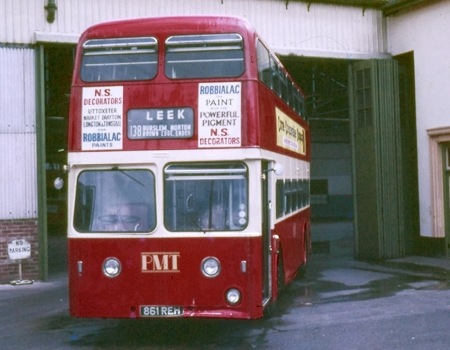Potteries Motor Traction
1961
Leyland Atlantean PDR1
Weymann L39/33F
This is one of a batch of 105 Atlanteans delivered between 1959/1961 and the above picture was taken at the water point at the PMT Newcastle under Lyme depot. It was very rare for this type of vehicle to do the Leek route as it was normally worked by Leyland Titan PD3’s and this bus would normally be on the Longton Newcastle Estates route. So it was a pleasure for me and a first to go to Leek in an Atlantean as I liked driving these splendid vehicles unlike the Daimler Fleetline which I detested. The prefix L in front of the fleet number denotes a low height body which was one of the reasons why this type of bus was normally on the Longton service as there was a low railway bridge in Longton.
During the Potteries annual holidays double deck vehicles would be used on the express service’s to Morecambe and Blackpool, the buses would be either Atlanteans or Fleetlines with Alexander bodies the latter being hard work with their hydraulic throttles and having a top speed of 42 mph, the Atlanteans on the other hand would do between 52-55mph.
Photograph and Copy contributed by Michael Crofts
22/02/11 – 10:06
Thanks, Michael, for this interesting picture of another early BET company Atlantean. As you say, they could really motor, but they didn’t half drink the diesel when doing so. That was just one of the reasons why some operators changed to Fleetlines; lower overall maintenance costs was another.
Roy Burke
22/02/11 – 19:54
Good to see this photo of what was the most common type of bus in the PMT fleet in my time working there. Longton Depot had some of the earliest batch and achieved phenomenal engine mileages of 400,000+ between failures. Frank Ling was the Depot Engineer there and maintained a very high standard of maintenance. My first winter there was a cold one and the Atlanteans frequently failed with the air system unloader valve frozen causing the vehicle to lose all air pressure and hence drive. The unloader valve was mounted under the cab in one of the coldest locations on the vehicle. A rag on a steel bar, dipped in diesel and set alight was the quickest means of unfreezing the unloader and restoring normal operation. Flywheel gland failures were another problem coating the engine bay in oil with the consequent fire risk (wiring fires in the Atlantean engine bays were not uncommon not aided by the wiring insulation becoming brittle with age and falling off). Quite a number of Atlanteans had to be rewired, some being dealt with by local Contractors as the level of work exceeded the available labour in Central Works at Stoke. Leyland tried adding a fan bolted to the fluid flywheel (more correctly the fluid-friction clutch) on a number of buses but there was no real improvement. As originally built, the chassis had rear light units fitted on the rear sub frame and which shone through holes in the fibreglass engine cover. PMT later fitted high level rear lights in the rear ‘tween decks panels thus eliminating the wiring to the sub frame lights located as they were in a very oily environment. The main rear lights were fitted to the lift up rear engine cover and the additional lights were necessary to provide rear lights at night if it were necessary to open the engine cover whilst on the road at night. Oh happy days!!
Ian Wild
22/02/11 – 19:55
The early Atlantean in low height form was a modified lowbridge bus in reality on the other hand the Fleetline with its drop centre rear axle was a true lowheight vehicle from the off It took Leyland until 1966 (four years after the first Fleetlines entered service) before they offered a low height chassis which removed the low bridge layout from the top deck. Having said this the Atlantean PDR1/2 was not one of Leylands finest although when it appeared the AN68 was what the Atlantean should have been from the off
Chris Hough
26/01/13 – 06:24
The seating in the forward part of the upper upper deck on these buses was too low in relation to the window line whilst the rear rows of 4 were too high! This is except the initial row of 4 which were mounted straight onto the raised rear platform resulting in an excellent match between seat height and window level.
Ian Wild

Leave a Reply